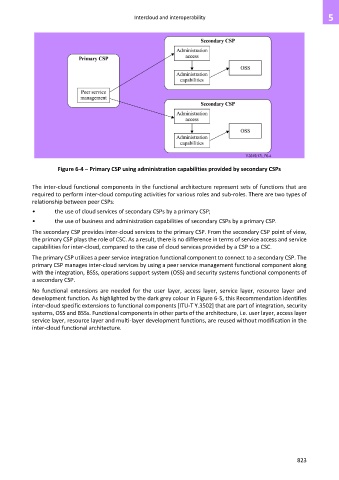Page 831 - Cloud computing: From paradigm to operation
P. 831
Intercloud and interoperability 5
Figure 6-4 – Primary CSP using administration capabilities provided by secondary CSPs
The inter-cloud functional components in the functional architecture represent sets of functions that are
required to perform inter-cloud computing activities for various roles and sub-roles. There are two types of
relationship between peer CSPs:
• the use of cloud services of secondary CSPs by a primary CSP;
• the use of business and administration capabilities of secondary CSPs by a primary CSP.
The secondary CSP provides inter-cloud services to the primary CSP. From the secondary CSP point of view,
the primary CSP plays the role of CSC. As a result, there is no difference in terms of service access and service
capabilities for inter-cloud, compared to the case of cloud services provided by a CSP to a CSC.
The primary CSP utilizes a peer service integration functional component to connect to a secondary CSP. The
primary CSP manages inter-cloud services by using a peer service management functional component along
with the integration, BSSs, operations support system (OSS) and security systems functional components of
a secondary CSP.
No functional extensions are needed for the user layer, access layer, service layer, resource layer and
development function. As highlighted by the dark grey colour in Figure 6-5, this Recommendation identifies
inter-cloud specific extensions to functional components [ITU-T Y.3502] that are part of integration, security
systems, OSS and BSSs. Functional components in other parts of the architecture, i.e. user layer, access layer
service layer, resource layer and multi-layer development functions, are reused without modification in the
inter-cloud functional architecture.
823

